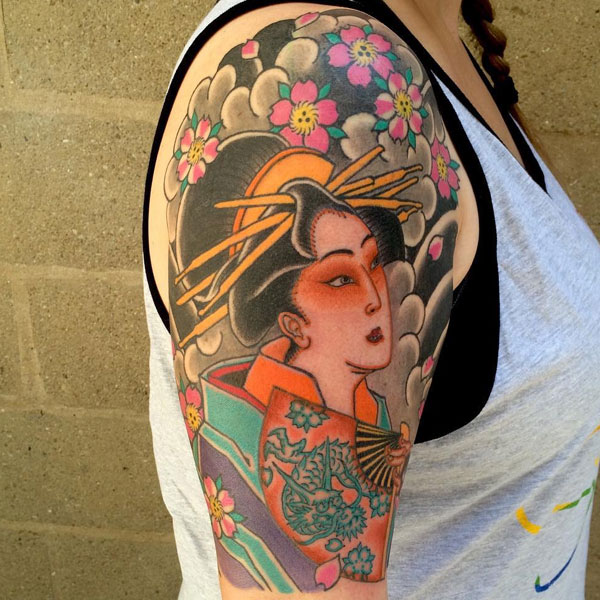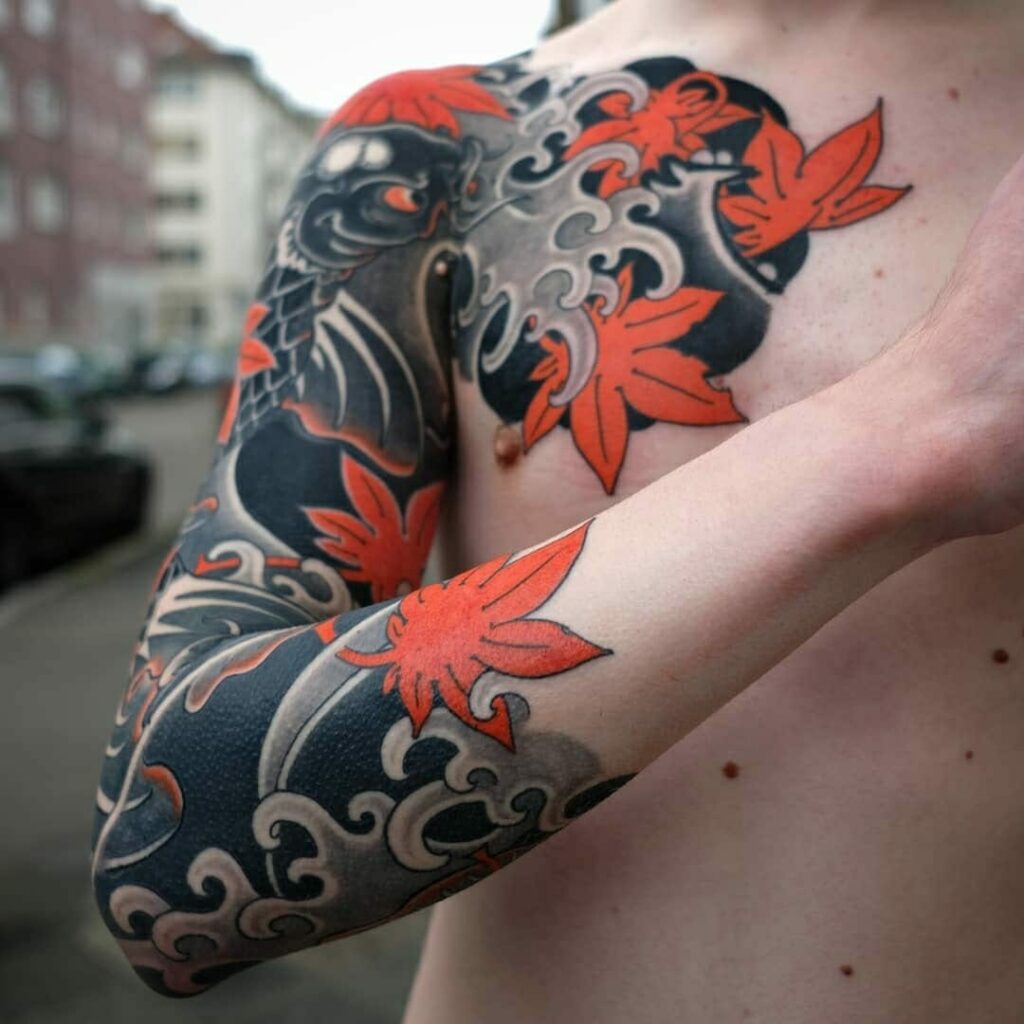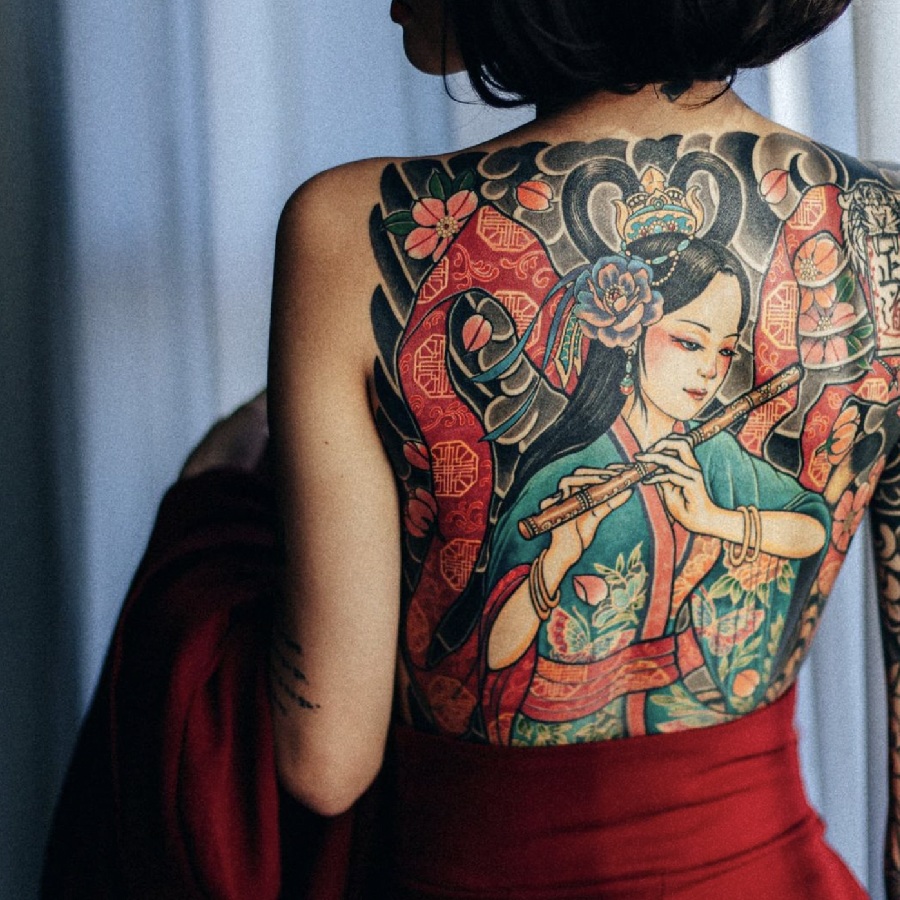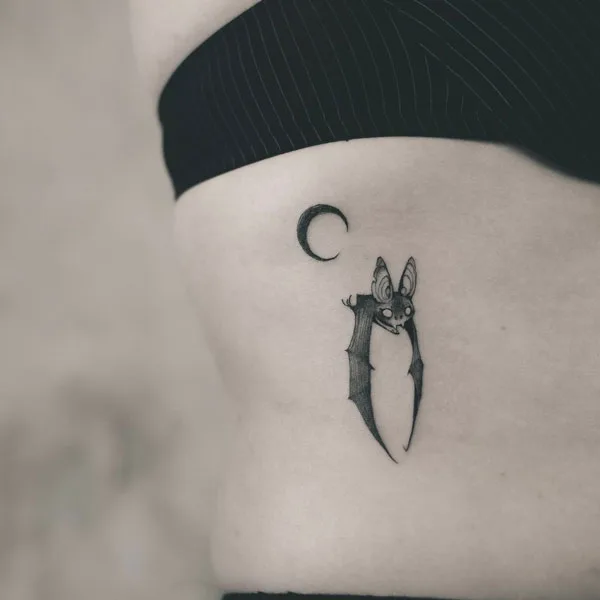
Mythical Inking Tradition: The Depths of Japanese Tattoo Art
The Origin and History of Japanese Tattoos
Japanese tattoos, or ‘Irezumi’, have a rich history stretching back centuries. This art form began as a means of expression, identity, and status within ancient Japanese society. It evolved over time, deeply interwoven with the culture’s spiritual and social fabric. Japanese tattoo art has faced its share of stigma, yet it has also seen periods of broad acceptance, making its history complex and fascinating.
The Spiritual and Social Significance
In the spiritual realm, Japanese tattoos often served as talismans or forms of protection. Religious and mythological motifs were common, believed to bring good fortune or ward off evil spirits. Socially, tattoos signified one’s place in the hierarchical structure of Japan. Certain clans and groups used distinct tattoos to indicate membership and rank, while others adorned their bodies for pure aesthetic pleasure. Nonetheless, there was a time when tattoos were used as a form of punishment, branding outcasts and criminals, essentially marking them for life.
The Edo Period and Ukiyo-e Influence
The Edo period marked a renaissance in Japanese tattooing. It coincided with the rise of Ukiyo-e, a genre of woodblock prints that had a significant impact on tattoo design. The era’s famed artists created intricate and colorful works portraying narratives from folklore and daily life. This richness of Ukiyo-e was mirrored in the Japanese tattoos of the time, leading to designs that were complex and visually stunning. Floating-world imagery and a penchant for storytelling through visuals permeated into the craft of Japanese tattooing, setting a precedent for the detailed and narrative-driven designs Japanese tattoo artists are renowned for today.
Iconography and Symbolism in Japanese Tattoos
Japanese tattoo art stands out for its rich iconography and symbolism. Each element in a Japanese tattoo holds meaning and tells a story. This depth of symbolism is a key reason why enthusiasts and collectors value ‘Irezumi’. Understanding the imagery within Japanese tattoos can provide insights into Japan’s history, nature, and mythology.
Mythical Creatures and Their Meanings
Japanese tattoos often feature mythical creatures, each allied with distinct tales and attributes. For instance, dragons symbolize wisdom, strength, and good fortune. They embody water elements, mirroring their importance in Japanese mythology. Another creature, the phoenix, represents rebirth and fire. Tattoos depicting the phoenix are thought to inspire transformation and triumph over adversity.
Koi fish, a prevalent motif, signify perseverance and success. The legend of the koi ascending the Dragon Gate waterfall inspires those overcoming hardships. Turtles stand for longevity and protection. Samurais favored them as they believed turtles aided in their endurance and defense.
Natural Elements and Their Representations
Natural elements in Japanese tattoos also carry powerful symbolism. Cherry blossoms, known as ‘sakura’, denote the transient nature of life, reminding us of beauty and mortality. The fierce and stunning imagery of waves and water implies life’s continuous flow and the wearer’s emotional strength.
Bamboo, resilient and flexible, symbolizes the ability to bend with adversity without breaking. The maple leaf, or ‘momiji’, represents the passage of time, emphasizing change and the beauty of the seasons.
Echoing these elements and symbols, ‘Irezumi’ artists craft tattoos that transcend mere aesthetics. They create wearable art steeped in tradition and cultural resonance, enhancing the allure of Japanese tattooing on the global stage.

The Art of Irezumi: Techniques and Tools
The traditional art of ‘Irezumi,’ or Japanese tattooing, has unique techniques and tools that set it apart. These methods have been honed over centuries, reflecting a deep respect for the craft. Two distinct approaches mark the practice of Japanese tattooing: the time-honored Tebori method and modern adaptations that embrace technological advancements.
The Tebori Method
The ‘Tebori’ technique is the classical hand-carving method of tattooing in Japan. In this method, the artist uses special tools to insert ink into the skin manually. These tools are often made from natural materials like bamboo and metal. The Tebori process is slow and meticulous, requiring substantial skill and a steady hand. Artists using Tebori create subtle gradients and dynamic shades that are hard to achieve with machine tattoos. This method also tends to be less painful and heals faster, as it causes less trauma to the skin.
Enthusiasts of Japanese tattoo often seek out the Tebori method for its authentic feel and the connection to the art’s historical roots. Despite being labor-intensive, it is prized for the unique texture and depth it gives to the tattoo.
Modern Adaptations in Japanese Tattooing
While Tebori remains popular, many ‘Irezumi’ artists now also use modern tattoo machines. These machines enable artists to cover larger areas more quickly and to create precise lines and details. The use of modern tools doesn’t mean that the tattoos lose their traditional Japanese qualities. Instead, artists blend contemporary methods with classic Japanese designs, maintaining the iconic style while implementing efficiency and precision.
Modern tools have also expanded the possibilities for tattoo art, allowing for more complex and vibrant imagery. Some Japanese tattoo artists experiment with combining Tebori and machine techniques in a single tattoo, offering a hybrid of traditional and contemporary application methods. This evolution in technique signifies respect for tradition paired with innovation, driving the art form forward.
As ‘Irezumi’ continues to evolve, both techniques find their place among artists and tattoo enthusiasts alike, each offering a different experience and aesthetic quality to Japanese tattoos.
The Aesthetics of Japanese Tattoos
Japanese tattoos, known as ‘Irezumi’, are widely celebrated for their striking aesthetics. The seamless integration of color and composition in these designs is both intricate and symbolic. This distinct visual appeal sets ‘Irezumi’ apart from other tattoo traditions and is a primary reason for its enduring popularity.
Color Usage and Composition
In the realm of Japanese tattoo art, color plays a pivotal role in the storytelling aspect. Artists carefully select hues to convey emotions and enhance symbolism. Vibrant reds often indicate strength or passion, while blacks and greys provide depth and perspective. The colors are not just for beauty; they breathe life into each design, ensuring that every ‘Irezumi’ piece resonates with visual impact and meaning.
The arrangement of elements within a Japanese tattoo is often deliberate and thoughtful. Each motif is positioned to complement the others, creating a harmonious composition. The choice of images, their sizes, and how they interplay contributes to a tattoo’s overall narrative and aesthetic balance.
Placement and Flow on the Body
The flow of Japanese tattoos across the body is another critical aspect of their aesthetics. Artists design tattoos with the wearer’s body shape in mind, enhancing natural curves and muscle contours. Placement is strategic, with back pieces, sleeves, and full-body suits being popular choices for ‘Irezumi’ faithful. These tattoos are crafted to move with the body, creating a dynamic art piece that’s both personal and profound. This consideration for the body’s natural flow leads to designs that are not just visually stunning but also work in harmony with the wearer’s movements.
In conclusion, the beauty of Japanese tattoos lies not only in their rich history and symbolism but also in their artistic execution. The thoughtful use of color, composition, and placement makes ‘Irezumi’ a true form of wearable art that honors tradition while embracing individual expression.
-min.jpg)
The Cultural Impact and Perception of Tattoos in Japan
The perception of Japanese tattoos, or ‘Irezumi’, varies widely within contemporary Japanese society. While some celebrate them as a form of artistic expression, others view them with a degree of skepticism, often associating them with antisocial behavior. This dichotomy stems from the diverse cultural influences and historical changes that have shaped the country’s outlook on body art.
Tattoos in Contemporary Japanese Society
Today, views on Japanese tattoos oscillate between admiration and disapproval. On one hand, the younger generation and subcultures within Japan are increasingly accepting ‘Irezumi’ as a mode of self-expression and as part of fashionable trends. This shift towards acceptance is also fuelled by international interest in Japanese tattoo art. Conversely, traditional views persist. In many public spaces, like baths and pools, tattoos are often prohibited, rooted in a desire to maintain social order and decorum.
The modern Japanese workforce also reflects mixed attitudes towards tattoos. Many companies maintain strict dress codes and view tattoos as incompatible with professional settings. This convention often forces individuals with tattoos to conceal their body art during work hours, sometimes limiting career opportunities. Nonetheless, as global influences continue to permeate Japan’s cultural barriers, tattoos are slowly becoming more normalized in various artistic and social circles.
The Influence of Yakuza on Tattoo Culture
The relationship between ‘Irezumi’ and the Yakuza, Japan’s organized crime syndicates, has played a significant role in shaping public perception. Traditionally, full-body tattoos have been a hallmark of Yakuza identity, symbolizing loyalty and commitment to the group. The intricate and often hidden tattoos are seen by some as emblematic of the secrecy and nefarious activities of the underworld.
This linkage has cast a long shadow over the art form, causing many to associate ‘Irezumi’ with criminality. As such, the stigma remains a hurdle for the art’s acceptance, despite the growing number of law-abiding citizens who embrace tattoos for personal and aesthetic reasons. Artists and enthusiasts work to disentangle these preconceptions, aiming to elevate the status of Japanese tattooing to that of an art form free from negative stereotypes.
In summary, the cultural impact and perception of Japanese tattoos are complex. They intertwine with a society that is at the crossroads between its traditional values and the modern, globalized world. While acceptance grows in some quarters, it clashes with enduring stigmas entrenched in Japan’s rich history and social constructs.
Renowned Japanese Tattoo Artists and Their Styles
Japanese tattoo, or ‘Irezumi’, has been defined and perfected by numerous esteemed artists throughout its history. These masters of the art form have played critical roles in shaping the techniques and aesthetics associated with Japanese tattoos, influencing both national and international tattoo culture.
Pioneers of the Art Form
Some of the pioneers in the Japanese tattoo art were instrumental in blending tradition with innovation. Among these, Horiyoshi III is often revered for his mastery and contribution to ‘Irezumi’. With over 40 years of experience, his work reflects a deep understanding of Japanese folklore and a respect for the Tebori technique. Another notable figure is Horihide, who began tattooing in the post-war era and was among the first to bring awareness of Japanese tattoo artistry to an international audience.
Tattooing in Japan isn’t just a form of art; it’s a lineage. Artists would often take a ‘Hori’ name symbolic of their mentor’s legacy, ensuring the continuity of their styles and methods. Each pioneer artist developed a distinctive style, such as intricate shading or bold color use, which often portrayed scenes from mythology and nature, crucial aspects of ‘Irezumi’.
Rising Stars in the Japanese Tattoo Scene
The contemporary Japanese tattoo scene continues to thrive with new artists making their mark. Artists like Gakkin and Nissaco have achieved recognition for their unique approaches to ‘Irezumi’. They blend modern techniques with classical motifs, creating bold, graphic designs that push the boundaries of traditional aesthetics.
Shige, another influential artist in the modern scene, has gained international fame for his innovative full-body suits that incorporate both traditional Japanese elements and more surreal, contemporary designs. Horimitsu is known for his immaculate Tebori techniques and maintaining the age-old traditions in his work while adapting to the evolving tastes of a modern clientele.
New artists are constantly emerging, embracing the rich heritage of Japanese tattooing while introducing fresh perspectives. They carry the torch lit by the pioneers, continually innovating and preserving the ‘Irezumi’ craft for the next generation of tattoo artists and enthusiasts around the world. The impact of these artists is not only felt across Japan but also globally as they draw in clients from all over, keen to experience the depth of Japanese tattoo art firsthand.

Getting a Japanese Tattoo: Considerations and Etiquette
Deciding to get a Japanese tattoo is a significant choice. It involves both deep thought and respect for the art form’s traditions. Below, we discuss key considerations and the etiquette you should follow when getting a Japanese tattoo. These range from selecting the appropriate motif to choosing the right artist. Plus, it’s vital to understand the long-term commitment and how to take care of your artwork.
Choosing the Right Motif and Artist
When it comes to selecting a motif for a Japanese tattoo, the symbolism is paramount. The images used in ‘Irezumi’, ranging from mythical creatures to natural elements, all carry rich meanings. It’s crucial to research and understand these symbols to ensure your tattoo accurately reflects your intended message or values.
Finding the right artist is just as important as picking the design. Look for someone skilled in the ‘Irezumi’ tradition. An experienced artist can guide you in choosing a motif that not only resonates with you but also harmonizes with ‘Irezumi’ standards. Do thorough research, read reviews, and view portfolios to find an artist whose style aligns with your vision. Remember, the best results come from a collaboration between your ideas and the artist’s expertise.
Understanding the Commitment and Care Required
Japanese tattoos require a long-term commitment, not just in time but also in care. They are a lifetime addition to your body and should be treated with the utmost respect. After getting a tattoo, following the aftercare instructions is crucial for proper healing and longevity of the design. This includes keeping the tattoo clean, avoiding sun exposure, and applying healing ointments as advised.
Be prepared for the upkeep as well. Tattoos may need touch-ups over the years to keep the colors vibrant and the lines sharp. Understand the investment you are making, both in the initial application and in maintaining the tattoo’s beauty over time.
In conclusion, getting a Japanese tattoo involves thoughtful consideration of design and finding the right artist. It also means committing to the care necessary to maintain your body art for years to come. By following these guidelines, you can ensure your ‘Irezumi’ experience is respectful, meaningful, and fulfilling.

